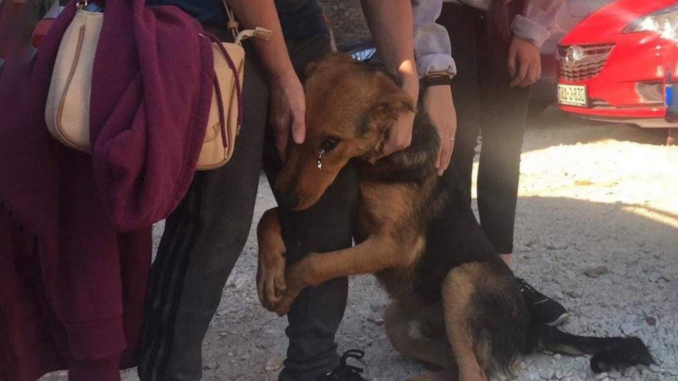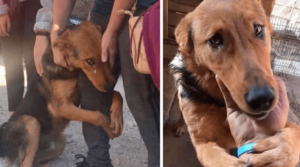
Imagine walking down the street, minding your own business, when a dog approaches you. You think it’s just another friendly pup looking for affection. But as you pet the dog, it looks at you with pleading eyes, as if asking you not to walk away. “Please don’t leave me alone there,” it seems to beg. This was the reality I faced when I first encountered a dog abandoned, hungry, and deeply scarred by months of neglect. This emotional plea was just the beginning of a long journey toward healing.
In this article, I’ll share the heart-wrenching story of a dog who, after being abandoned and left to fend for itself, began to trust again—slowly, with time, love, and patience. You’ll learn how this dog went from begging strangers for help to finding happiness and safety in a loving home.
The Moment of Begging: A Heartbreaking Encounter
The first time I saw him, it was clear this dog had been through far too much. His fur was dirty and matted, his ribs were visible under his thin coat, and his eyes reflected a deep sense of sadness. But what struck me the most was his behavior. As I stopped to pet him, I could see his hesitation, but also a desperate plea in his gaze. When I tried to walk away, he followed me, and I distinctly heard him make a soft whine, almost like he was begging, “Please don’t leave me alone there.”
It was at that moment that I realized this dog was not just looking for affection. He was desperately seeking safety, reassurance, and love. His past had left scars that went far deeper than his physical appearance.
Why Do Abandoned Dogs Beg for Attention?
Dogs who have been neglected or abandoned often develop behaviors that are their way of pleading for help. They’ve learned that showing vulnerability can sometimes lead to a bit of care or attention. For this dog, begging was his way of trying to communicate his need for a new chance at life—one where he didn’t have to face each day in fear and isolation.
The First Steps Toward Rescue: Bringing Him Home
I couldn’t turn my back on the dog’s plea. After a few moments of hesitation, I decided to take him with me. I knew that bringing him home would be a significant commitment, but it was the right thing to do. I made sure to consult a vet immediately, as it was clear he needed medical attention.
What to Do When You Encounter an Abandoned Dog
If you come across a dog in a similar situation, the first step is to make sure it’s safe. Gently approach the dog, assess its health, and try not to startle it. If it seems friendly and willing to accept help, take the dog to a vet for a health check-up and to see if there’s any microchip that could lead you to its owner. In many cases, abandoned dogs are left to fend for themselves with little to no care, so offering help is essential.
Healing the Wounds: Physical and Emotional Care
Bringing an abandoned dog into a new environment is just the beginning. Once home, it was clear that my new companion needed both physical and emotional healing. His body was weak from malnutrition, and his mind was fractured from the trauma of abandonment. But with time, patience, and consistent care, things began to improve.

Physical Healing: Restoring Health and Strength
The first step was addressing his physical health. His thin frame, dry coat, and lack of energy were clear signs of neglect. I started him on a high-quality diet, ensuring he received the nutrients he needed to regain strength. It was important to introduce food gradually to prevent any stomach issues, but after a few weeks, I noticed a significant improvement. His coat began to shine, and he seemed to have more energy.
Emotional Healing: Earning His Trust
Emotional recovery was more complicated. This dog, who had once begged strangers not to leave him alone, had a deep-seated fear of abandonment. It wasn’t just about physical affection; it was about giving him the emotional security he needed. I made sure that our routines were consistent—feeding him at the same time every day, taking him for regular walks, and most importantly, showing him love without conditions.
Trusting Again: How Love Makes a Difference
Trust takes time, especially when it’s been broken by people or situations. Initially, my dog was hesitant to approach me or anyone else for long periods. He would sometimes hide under the bed or in corners when people entered the house. But slowly, through positive reinforcement and gentle care, he began to trust me. His tail would wag when I entered the room, and eventually, he started to come to me for pets and affection.
Rebuilding a Broken Spirit: The Power of Play and Companionship
Another key aspect of helping him heal was engaging in play. Abandoned dogs often don’t know how to interact with toys or other dogs, as they’ve never had the opportunity to experience joy in that way. However, through patience and encouragement, I was able to introduce him to the world of toys and play.
Learning to Play: How a Neglected Dog Finds Joy Again
The first time I threw a ball and he actually chased after it, I saw a glimpse of his former self—a dog capable of joy, excitement, and trust. Over time, he learned to play more confidently, and it became a significant bonding activity for us. Play is not just about physical exercise; it’s an emotional experience that helps dogs develop trust, confidence, and social skills.
Companionship: The Role of Other Pets
Eventually, I introduced him to my other pets, and seeing how he interacted with them helped him learn to trust both animals and humans. His new friends helped him realize that he wasn’t alone anymore and that he had a family who cared for him.
The Road to Recovery: Patience and Time
Healing isn’t immediate, and it’s important to have realistic expectations when rescuing an abandoned dog. It took several months before my dog stopped having moments of anxiety and fear. But every day, he became more comfortable, and every day, I saw a little more of his personality shine through.
Long-Term Care: Providing Ongoing Emotional Support
Even after months of living together, my dog still experiences moments of fear. There are certain noises that still startle him, and he sometimes exhibits signs of separation anxiety. However, I’ve learned to read these cues and offer reassurance through calm words, soothing touch, and consistency in our routine.
From Begging to Belonging: A Happy Ending
Now, my dog is no longer the frightened, starving animal I first encountered on the street. He’s a happy, playful, and confident dog who knows that he is loved. His plea for help is no longer a cry of desperation; it’s a distant memory of a time when he didn’t know what safety and love felt like.
The Transformative Power of Compassion
The journey of rescuing and healing a dog that has been abandoned is challenging, but the rewards are immense. There’s nothing quite like watching a dog go from begging for affection to offering it freely. My dog now runs to greet me with excitement, wagging his tail and eager to share his love. His transformation is a testament to the power of compassion and patience.
Conclusion: A Second Chance at Happiness
Rescuing a dog who’s been abandoned, hungry, and emotionally scarred can be one of the most rewarding experiences. It’s not just about saving a life—it’s about giving that dog the chance to live a happy, fulfilling life. If you come across a dog who’s begging for love, remember that your kindness could be the beginning of their healing journey. Don’t turn away, because every dog deserves a second chance.
FAQs
1. What should I do if I see an abandoned dog begging for help?
If you encounter a begging dog, approach it gently and assess its condition. If it’s safe to do so, take it to the vet for a checkup. Contact a local animal rescue or shelter if you’re unsure about how to care for the dog.
2. How can I help a dog who has suffered from neglect?
Providing food, medical care, and a safe, quiet space is crucial. Building trust through patience, love, and consistency will help the dog heal emotionally.
3. How long does it take for an abandoned dog to trust again?
Trust can take time, sometimes months or even longer. The key is consistency, patience, and creating a predictable, loving environment.
4. Is it possible for an abandoned dog to become happy again?
Yes, with time and care, an abandoned dog can heal both physically and emotionally, and eventually experience happiness again.
5. What are the signs that a neglected dog needs immediate help?
Signs include malnutrition, thin or matted fur, visible injuries or scars, extreme fear of humans, or signs of depression. If you notice any of these signs, take the dog to a vet immediately.
